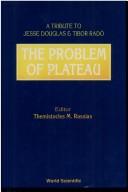| Listing 1 - 3 of 3 |
Sort by
|
Book
ISBN: 9076686068 9789076686066 Year: 2001 Publisher: Gent Provincie Oost-Vlaanderen
Abstract | Keywords | Export | Availability | Bookmark
 Loading...
Loading...Choose an application
- Reference Manager
- EndNote
- RefWorks (Direct export to RefWorks)
Theatrical science --- stroboscopische schijven --- filmgeschiedenis --- Plateau, Joseph --- Belgium --- Catalogues d'expositions --- Tentoonstellingscatalogi --- Plateau, Joseph, --- 378.4 <493 RUG> --- 378.4 <493 GENT> --- Universiteiten: Rijksuniversiteit Gent--RUG --- Universiteiten--België--GENT --- 378.4 <493 GENT> Universiteiten--België--GENT --- 378.4 <493 RUG> Universiteiten: Rijksuniversiteit Gent--RUG --- 791.43.07 --- Filmregisseurs, acteurs, filmografen --- Exhibitions --- 791.43.02 --- Phenakistiscoop --- Stroboscopie --- Animatiefilm ; bewegende beelden ; pioniers --- Film ; pre-cinema ; 19de eeuw ; J. Plateau --- Plateau, Joseph Antoine Ferdinand1801-1883 (°Brussel, België) --- Belgische kunstenaars --- Filmkunst ; technieken --- film --- filmtechniek --- 791.471 PLATEAU --- 791.43 --- precinema --- Plateau Joseph --- voorgeschiedenis film

ISBN: 9810205562 9789810205560 Year: 1992 Publisher: Singapore ; River Edge, NJ World Scientific
Abstract | Keywords | Export | Availability | Bookmark
 Loading...
Loading...Choose an application
- Reference Manager
- EndNote
- RefWorks (Direct export to RefWorks)
Oppervlakken [Minimale ] --- Plateau [Problème de ] --- Plateau's problem --- Probleem van Plateau --- Surfaces [Minimal ] --- Surfaces minimales --- Minimal surfaces --- Plateau, problème de --- Douglas, Jesse, --- Plateau, Joseph, --- Radó, Tibor, --- Plateau's problem. --- Minimal surfaces. --- Surfaces, Minimal --- Maxima and minima --- Minimal surface problem --- Plateau problem --- Problem of Plateau --- Radó, T. --- Radó, Tibor, --- Plateau, problème de
Book
ISBN: 9783110426960 311042696X 9783110422993 3110422999 9783110423037 3110423030 3110423006 3110423030 Year: 2016 Publisher: Berlin Boston
Abstract | Keywords | Export | Availability | Bookmark
 Loading...
Loading...Choose an application
- Reference Manager
- EndNote
- RefWorks (Direct export to RefWorks)
Die avancierten Kunstschaffenden haben seit jeher innovativen Erfindungen aus dem Bereich der Naturwissenschaften zu den Themen Licht und Perspektive für ihre Darstellungen eingesetzt und dabei nachweislich sogenannte Sehapparate verwendet. Seit Anfang der zwanziger Jahre des 20. Jahrhunderts setzten sich Künstler wie Marcel Duchamp mit Scheinbewegungen auseinander. Aufbauend auf diesen frühen Ideen und künstlerischen Experimenten kam besonders die Scheinkontur durch die Beschäftigung mit Scheinräumlichkeit zu neuem Interesse, vor allem vonseiten der Vertreter der kinetischen Kunst und der Op-Art. Seeing Motion gibt einen Überblick entlang einer historischen Linie, die sich zwischen den Theorien der experimentellen visuellen Wahrnehmungsforschung (Hermann Helmholtz, Ernst Mach, Sigmund Exner, Wilhelm Stern, Vittorio Benussi, Max Wertheim, George Stratton, Ivo Kohler) bis hin zur apparativen Kunst (Alfons Schilling) sowie zur elektronisch-digitalen Kunst (Jeffrey Shaw, Peter Weibel) abzeichnet. The central focus of this publication is the synthesis of science and art in the field of visual perception, in particular how early 19th century perceptual research into illusions, kinetic illusory figures, and illusory movement influenced the apparative / machine, kinetic art of the 20th century and the computer-generated visual art of the 21st century. Professional artists have traditionally used innovative, scientific inventions involving light and perspective for their work as well as making use of “visual aids”. Since the beginning of the 1920's, artists like Marcel Duchamp have been experimenting with illusory movement. Based on these early ideas and artistic experiments, and due to its relationship with illusory space, there was a renewed interest in illusory contour, especially among representatives of kinetic art and op art. Seeing Motion provides an historical overview extending from the theories of experimental visual perception research (Hermann Helmholtz, Ernst Mach, Sigmund Exner, Wilhelm Stern, Vittorio Benussi, Max Wertheim, George Stratton, Ivo Kohler) to apparative art (Alfons Schilling) and electronic-digital art (Jeffrey Shaw, Peter Weibel).
kunst --- wetenschap --- kunst en wetenschap --- 7.01 --- 7.036/039 --- 7.03 --- Schilling Alfons --- Weibel Peter --- Shaw Jeffrey --- Duchamp Marcel --- Erismann Theodor --- Hildebrand Franz --- Stratton George M. --- Kleint Herbert --- Duncker Karl --- Wertheimer Max --- Benussi Vittorio --- Basler Adolf --- Szily Adolf --- Hescheles Leo --- Borschke Alfred --- psychologie --- Hoppe Johann Ignaz --- Exner Sigmund --- licht --- Mach Ernst --- Czermak Josef --- Brücke Ernst --- Helmholtz Hermann --- Filehne Wilhelm --- Zöllner Johann Karl Friedrich --- antirheoscoop --- optica --- Fechner Gustav Theodor --- Talbot-Plateau --- stroboscoop --- phenakistiscoop --- Plateau Joseph --- Roget Peter Mark --- Purkinje Jan Evangelista --- voorgeschiedenis film --- filmgeschiedenis --- filmtheorie --- film --- waarneming --- kinetische kunst --- beweging --- eenentwintigste eeuw --- twintigste eeuw --- kleurenleer --- kleur --- kunsttheorie --- perceptie --- Stratton George M --- Visual perception. --- Optical illusions in art. --- Science and the arts. --- Movement perception (Vision) --- Motion perception (Vision) --- Optics, Psychological --- Vision --- Perception --- Visual discrimination --- Psychological aspects
| Listing 1 - 3 of 3 |
Sort by
|

 Search
Search Feedback
Feedback About UniCat
About UniCat  Help
Help News
News